- How to colorize step by step
- Technique and technology of execution step by step: schemes
- Coloring technique:
- Coloring techniques
- Coloring benefits
- Actual color solutions of painting
- Conditions for the selection of the shade color
- FOR DARK AND BLACK HAIR
- FEATURES FOR LIGHT HAIR
- OWNERS OF RED BROWS
- Hair coloring: what is it?
- Fashionable types of coloring
- Choosing a coloring technique depending on the length of the hair
- For short hair
- For medium length hair
- Long hair
- Conclusion
How to colorize step by step
Coloring is the coloring of individual strands in tones other than natural. It can be produced vertically or horizontally.
The procedure is performed by a master colorist who achieves the desired result by mixing several tones. Hair coloring, especially at home, requires the greatest care and labor.
The largest number of colors used by a hairdresser: 18-20 shades.

Technique and technology of execution step by step: schemes
There are two types of coloring:
- Vertical. In this case, 19 shades are used for coloring. In this case, one strand is painted in only one tone.
- Horizontal. To perform the procedure, 4 shades are used. To make staining using this technology, the hair is divided into three parts. Further, each part is divided into several strands. After that, a dark-colored paint is applied to the root of the curls, the lightest shade is applied to the ends, and the middle is painted in the remaining two tones - darker at the top, light at the bottom.
If you remember the diagrams, you can carry out the procedure yourself.
To perform staining you will need:
- several tones of paint;
- a plastic or glass container for diluting the dye;
- hairbrush;
- brush for applying the product;
- plastic gloves for hand protection;
- fat cream;
- foil.

Coloring technique:
- the paint is applied to dirty, dry curls, so it is not recommended to wash your hair 3 days before the procedure, and also to use styling products;
- the epidermis along the hairline is treated with a cream;
- strands that will stain are separated from the hair, the rest of the curls are fixed with an elastic band;
- first, only one composition is used, the paint is applied to the curls, moving from the back of the head to the front of the head, after processing, the strands are wrapped in foil;
- apply the second composition and so on, until all the coloring agents are used and all the strands are processed;
- the product is kept for 30-40 minutes, after which it is washed off, each strand is alternately unfolded and doused with water;
- curls are washed with shampoo and balm.

Coloring techniques
There are a huge number of coloring techniques, despite the fact that there are only two types of coloring: vertical and horizontal. Vertical coloration means coloring the strands in about 19 different shades (although many believe that vertical coloration starts at 4 shades).
In this case, each strand must be painted in one shade.
Horizontal coloring implies the presence of only 4 shades. Hair with horizontal coloring is divided into 3 segments and each of these segments into several more. Then the darkest tone is applied at the roots, the lightest at the tips, and the middle is painted in a medium tone.

There are 6 basic coloring techniques:
- American coloring. Ideal for brunettes. When using the American coloring technique, you need to choose 5 different shades that match your natural hair color.This technique is not suitable for fair-haired girls.
- Coloring "Salt and pepper". Ideal for fair-haired girls and those who need to paint over gray hair, as at the roots the hair is dyed in lighter shades, and the ends are made darker.
- Multi-color coloring. This technique implies completely arbitrary coloring of the strand in all natural shades. This technique will work equally well on dark and light hair. Age, like natural hair color, also does not play a special role.
- Coloring on the bangs. This technique speaks for itself. It involves dyeing only the bangs, while the bulk of the hair is not used at all.
- Zonal coloring. This coloring technique involves dyeing only certain sections of the hair. Zonal coloring also implies the creation of peculiar patterns on the hair. But for this it is necessary to use brighter shades so that the pattern is noticeable.
- Neon coloring. Looks great on dark hair. With neon coloring, bright and catchy shades are used, due to which the image looks even slightly defiant. When using this technique, the hair is first lightened, and only then the strands are dyed in bright colors.
The disadvantage of this technique can be considered the fragility of such staining. After 2 weeks, the paint from the strand begins to wash off.

Coloring benefits
You are familiar with the situation when you came to the salon, expanded the palette of the proposed shades of dyes and cannot stop at any one - you like everything! Or at least five of them. Coloring allows you to solve the problem of choice brightly and in a compromise.
Choose all five and create a unique styling - that's the main advantage of this technique.
In addition, by choosing this type of hair coloring for yourself, you get:
- visual splendor and density of hair;
- three-dimensional hairstyle, eye-catching volume of even naturally thin hair;
- expressiveness of a multi-layered, structured haircut;
- lively color of curls;
- showiness and brightness of the hairstyle;
- the ability to change the image by simply changing the styling - by combing your hair up or to the side, you can get a completely different shade and color.

Actual color solutions of painting
The classic colorization option for dark hair is the technology of dyeing strands near the face in light shades. This color looks natural, especially if you choose the right color. Tones such as white gold, platinum and ivory work best.
Let's consider what are the actual methods of coloring with a combination of different shades:
- babylights - this is the creation of soft highlights that resemble the strands of babies in the sun. This coloring looks very natural and gives shine to the hairstyle;

- glare. They resemble the previous method, but they are brighter and applied just below the roots.
- ombre. This trendy technique involves a sharp transition from dark to lighter colors. It has been popular for several seasons. Stylists recommend ombre in the summer season.
- sombre - this is an ombre variant with the difference that the transition from dark to light will be smoother. A great option for the cold season.
- chaumbra - the main color is mixed with a different palette of shades. The most commonly used colors are purple, red, green and blue.
- balayazh. Thanks to the precise strokes of the master, the effect of "burnt-out" curls is achieved.

- booking - an intermediate option between a blonde and a brunette, a combination of dark and light strands. Will give visible volume.
- pixel hair coloring. This hair coloring technique was developed by Spanish artisans. It involves the creation of a geometric pattern on the hair. Suitable only for brave girls with straight, sleek hair.
- trendy wine and eggplant marsala. A very fashionable today coloring technique, in which the shade of the hair resembles the noble color of red wine. It can be used both as the main one and as a complement to many chocolate and chestnut tones.
The variant of the combination of the shade "Marsala" with the violet spectrum looks especially beautiful. The result is a deep shade reminiscent of a rich, ripe plum wine.
- merlot is another trend of this season. It is a hair coloring in a deep and thick merlot color with subtle notes of ripe cherry and cocoa. This interesting color sits on the border of purple and red, so if desired, it can be adjusted to suit any skin tone.

Conditions for the selection of the shade color
Choosing a hair color for coloring is not an easy task. Shades should suit your type and at the same time be compatible with each other.
The main feature of coloring dark hair is preliminary bleaching. This is necessary for the best color development.
Basic rules for choosing colors for coloring dark hair:
- girls summer color type golden shades, as well as caramel, hazelnut, chocolate and light blond, will be very suitable for your face.
- «cold»Beauties should pay attention to the platinum, ash, and dark - blond colors.
- bright brunettes red tones are suitable, as well as purple and blue.
- brunettes you should give preference to chocolate shades.
- bright skin with freckles will look good in a frame of chestnut and golden tones.
- swarthy it is better for beauties to prefer black and dark brown colors.

Coloring on long hair looks especially impressive. In this case, it is recommended to select 2–3 tones close to natural and perform coloring in the longitudinal direction.
For medium hair lengths, most options will work. Girls with shoulder-length hair can choose up to 8 shades, and this neighborhood will look very organic. Patterned coloring looks unusual on medium-length hair.

For girls with short hair, longitudinal coloring with a small number of shades is suitable. A big plus of performing such coloring is the ability to modify the hairstyle depending on the styling.
Shades for coloring are also selected depending on the age of the lady.
So, for young beauties, there are no special restrictions in choosing a shade. Girls can dilute their dark strands with a pronounced color - orange or red. However, it is important not to overdo it here. To get a good result, you only need to take a few auxiliary shades.

If the coloring is performed by a woman over 35 years old, then the choice of color should be approached more thoroughly. The best option for such ladies will be a chestnut tone, which will go well with dark or black hair.
You should not use blue and purple tones for dark-skinned ladies: they will give the face a green or yellow tint. You can pick up copper and gold tones, but they should be in moderation.
As you can see, coloring on dark hair does not have a huge selection of shades. But that doesn't mean you can't get a stylish hairstyle. If one of the coloring techniques is performed correctly, the effect will be great.

FOR DARK AND BLACK HAIR
If you have dark and black hair, the best option would be to perform ombre - lightening and coloring the lower part of the hair. The colors and their combination must be chosen based on the color type of your appearance. Often, owners of dark hair belong to the “winter” color type, which leads to a harmonious combination in the image of cold shades.
In this case, the following sequence of actions is given:
- We carry out a three-stage lightening and correct the color using a tint shampoo / balm.
- Wait a few days (about two to three) before staining.
- We carefully comb the hair and divide it into four zones: bangs, front part (without bangs), crown, nape. We fix them with a hairdressing clip.
- Apply the product to the ends of the hair about four centimeters.
- We put foil under each strand.
- We do the same with the entire mass of hair. If the bangs are not long, you do not need to dye it.
- Let the paint take effect (wait about 15-20 minutes).
- After the specified period, unfold the foil and look at the result. If there is no clarification, wait a few more minutes.
- With our hands we apply the clarifier to the middle part of the curls.
- We wrap them together with the tips and leave for fifteen minutes.
- We unfold the foil and apply the clarifier two centimeters above the colored strands, leaving a little for the ones that were already clarified earlier.
- Wrap the curls in foil again and leave for ten minutes.
- After dyeing, wash your hair with a neutralizing shampoo.

FEATURES FOR LIGHT HAIR
In the event that you have light or light brown hair, the balayage technique will be the most optimal colorization option, which implies coloring the lower part of the strands using the “pulling” method.
Very suitable for young girls, whose appearance belongs to such color types as "spring" or "summer". The combination of cold and warm shades will come in handy.
To carry out this staining, you must do the following:
- We determine which area of the hair will be colored (usually the back of the ears), and we separate it using the zigzag method.
- We paint the occipital part in a darker color.
- We fix the colored curls with foil and fasten with a hairdressing clip.
- Apply paint of a different color (tone, shade) to the remaining strands and attach it with a clip to the strands already wrapped in foil.
- We paint the curls belonging to the parietal zone in a light color.
- We also wait 10-15 minutes for the paint to work.
- We wash it off with warm water and wash your hair with shampoo.

OWNERS OF RED BROWS
If you can proudly call yourself the owner of red hair, then coloring will be very useful for you! The fact is that the red color itself is very bright (even natural). Therefore, they paint it for various reasons. Someone wants to shade a little with neutral colors, and someone, on the contrary, to give the hairstyle brightness and visibility.
In either case, coloring individual strands in tones of somewhat similar color will look spectacular and attractive in every sense.
In terms of the technique, coloring red hair is similar to ordinary highlighting, the only difference is that several colors are used at once.
In addition, since red-haired girls often belong to the “autumn” color type, the choice of colors should be guided by a warm and cozy palette of shades.
Let's analyze the staining technique point by point:
- First of all, we will prepare a dye mass of different shades of the same color (it can be light, chestnut, or even some unusual color like blue or red, yellow, green, but tonics are usually used for such cases).
- We separate from the total mass of hair those areas that we will not dye, and fix them with hairdressing clips.
- After making sure that the distance from one strand to be dyed to another is no more than one centimeter, we paint them, starting from the back of the head, wrapping one strand after another in foil (no more than three centimeters wide). The last to paint the curls on the temples.
- Let the paint take effect. This usually takes 15-25 minutes. If, after unrolling the foil, you see that there is no effect, leave the paint for a few more minutes.
- Then rinse off the paint and wash your hair with shampoo.

Hair coloring: what is it?
Coloring is a technique for dyeing hair using more than three colors that are similar in color.Experienced colorists harmoniously combine up to 15 shades, making the hairstyle multifaceted and sophisticated. Do not confuse coloring with highlighting - a procedure in which hotel strands are lightened or colored with the same color.
Coloring advantages:
- revitalizes hair, adds volume;
- ennobles the color, makes it rich, diverse;
- Underlines the features of the haircut, structures;
- makes it possible to experiment, change the image.
The coloring procedure is performed in the following ways:
- Partial - the natural hair color is played up, complemented by several shades that make it richer.
- Complete - the natural color is completely replaced by other tones.
- Zonal - only certain areas are painted: bangs, whiskey, tips.
- Longitudinal - curls are painted over the entire length in one color. Strands of different shades alternate.
- Transverse - smooth horizontal color change. Each curl is painted over with different shades - from dark to light.

Coloring is a complex technique that requires a highly skilled hairdresser. He feels the shades, combines them correctly, taking into account the structure of the hair.
Fashionable types of coloring
There are many types of coloring, which differ in color combinations, smooth transition, and complexity of execution.
Popular varieties:
- California (American). A fashionable type of dyeing, which is to create the effect of burnt-out strands. It is carried out by gradually lightening individual curls. As a result, the tips differ from the base color by 5 tones. Suitable for any hair - even dark curls will sparkle with new golden tints.

- Ombre. Actual painting procedure. The peculiarity lies in a blurry, but sharp, contrasting transverse transition from a dark tone to a light one.

- Sombre. A soft alternative to ombre. The main difference is a smooth, gradual transverse transition from a rich base to light ends. In addition, not all hair is dyed, but the selected strands - this method is more natural, more gentle.

- Shaumbra. A creative variety of coloring, which is often called multi-colored coloring. It consists in adding bright green, blue, purple strands to the main color.
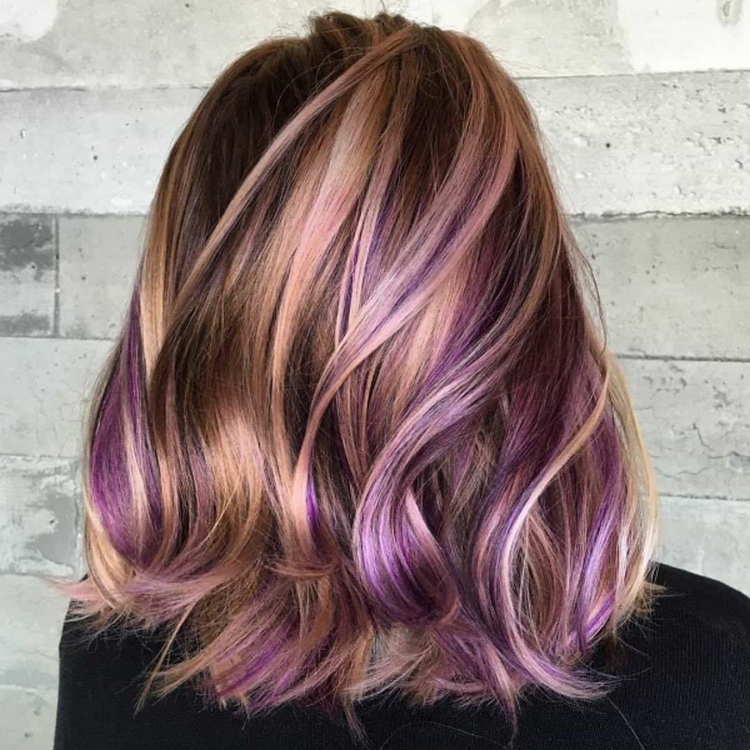
- Balayazh. Another technique that creates the effect of burnt curls. In this case, the emphasis is on the contrast between the base color and the tips. Blondes make the transition from natural blonde to cream soda shade. For brown-haired women and brunettes, the fashionable version of the "tiger's eye" is suitable - dark shades turn into golden, caramel, amber overflows.

- Booking. Spectacular coloration based on contrasting black and white combination. Light highlights on dark hair add freshness and lightness to the look. In booking, zonal coloring is often used - the strands near the face or on the bangs are lightened.

Pixel. A new extravagant trend in color. On the main tone, using a stencil, drawings are applied in the form of rectangles of different colors and sizes, which resemble pixels. Bright neon colors are used - blue, red, orange, green. This procedure will create the desired effect only on straight, smooth hair.

- Babylights. Soft highlights on the hair are created by frequent, chaotic, short strokes on thin strands - it looks natural and romantic.
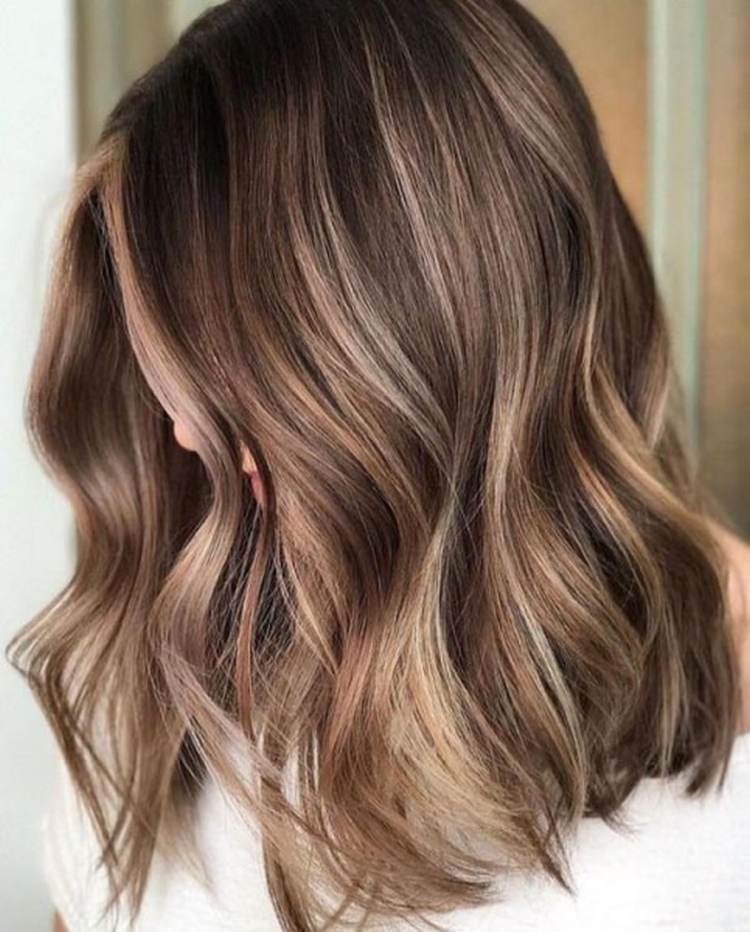
- Glare. A kind of zonal coloring. It consists in lightly lightening areas in the middle of the curls. The sensation of a falling sunbeam is created.
Choosing a coloring technique depending on the length of the hair
Hair length and structure are the criteria that help you choose the right color method. In addition, the shape of the face and the color type of appearance are taken into account.
The main rule when painting is that cold and warm tones in one hairstyle do not mix.
Coloring is applied to all types of hair - straight and curly, short and long, but the effect will be different in each case.
For short hair
Coloring on short hair looks stylish, makes the outlines clear, hair voluminous, interesting. They are painted with shades close to natural color, or contrasting bright accents.
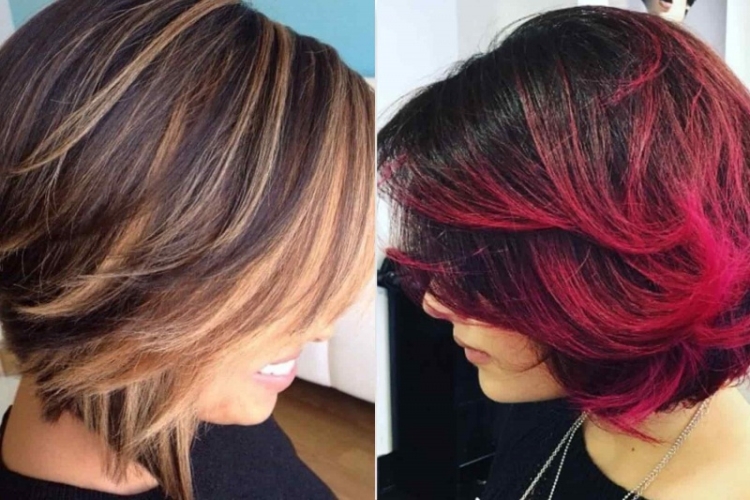
Such fashionable ultra-short haircuts like pixie, garcon become catchy, expressive with the help of longitudinal toning. The zonal coloring of individual torn asymmetric strands, long oblique bangs looks great.
An interesting image is created with the color "salt-pepper" - lightening the hair at the roots and contrasting dark ends.
Classic women's haircuts bob, bob, bob-bob, combined with coloring, get a new fresh breath. Longitudinal coloring makes the hairstyle soft, elegant, transverse clear transitions emphasize the structure and complexity of the haircut.
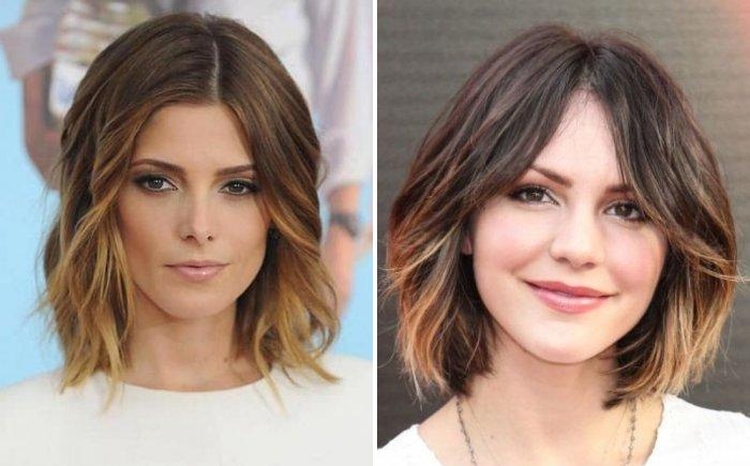
The peculiarity of dyeing for short hair is that you should not apply many shades. With insufficient length, they will simply merge, make the image washed out, inharmonious. Three-color coloring is considered optimal, but not more than 4-5 shades.
The best staining techniques are American, sombre, chambray, balayage, bronzing. For brave ladies, a good painting method is pixel, rainbow or neon coloring.
For medium length hair
Medium length hair is the best option for coloring. Multicolor dyeing makes the strands iridescent, deep, and makes the effect of high cost. Sufficient length allows for a variety of ways - full, partial, soft, creative. Longitudinal coloring brings romantic, elegant notes to the image.
Haircut cascade goes well with sombre, balayage, bronding. Contrasting strands add originality to the hairstyle.

The clarity of the lines and the structured shape of such haircuts as an elongated bob, long bob, bob with asymmetry is achieved by coloring with ombre, sombre, balayage. Expressive accents are created by zonal toning of bangs, strands of the face.
Experienced masters are able to make coloring in such a way that when changing the method of styling, the hair color changes.
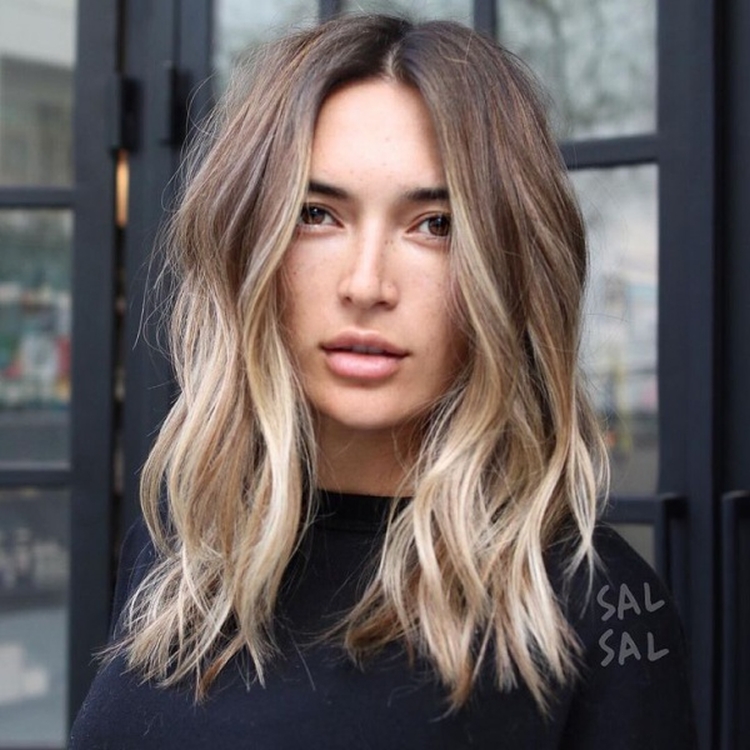
Long hair
Long hair creates unique opportunities for experimentation, the use of original color schemes. Coloring enriches the strands, refines, gives the hair a precious shine, a sense of depth with the help of a 3d effect.

All types of coloring look great on long hair - clear ombre, soft sombre and balayage, bright chambray. Partial coloring is often used - this method is more gentle on the hair.
Romantic light highlights of babylights coloring will make your hairstyle light and mysterious.

As a result of competent coloring, a multi-level haircut cascade takes on a harmonious shape. The discreet ladder becomes voluminous and varied. Coloring revives long straight and curly hair, arranges thick curls, adds volume to thin strands.

It is important to understand that only healthy and well-groomed hair looks beautiful. It is difficult to correctly perform coloring for a considerable length, it requires skill. It is not recommended to use the home paint option.
Conclusion
Coloring is a difficult and painstaking job that requires certain knowledge and skills. These conditions are indispensable for obtaining a spectacular and beautiful hairstyle. In addition to choosing the right shade, the quality of the paint also plays an important role. When choosing paint, give preference to auto manufacturers.
